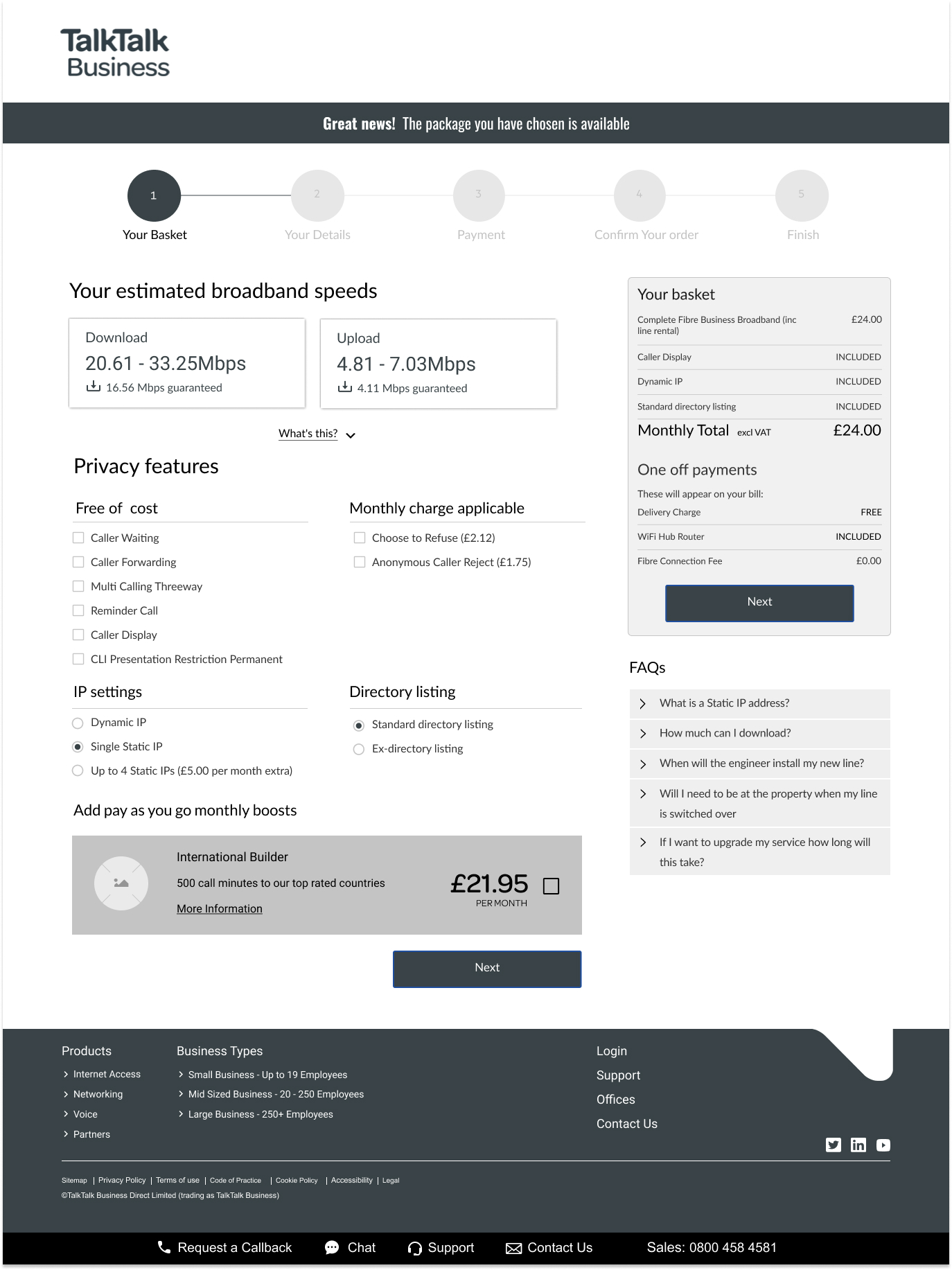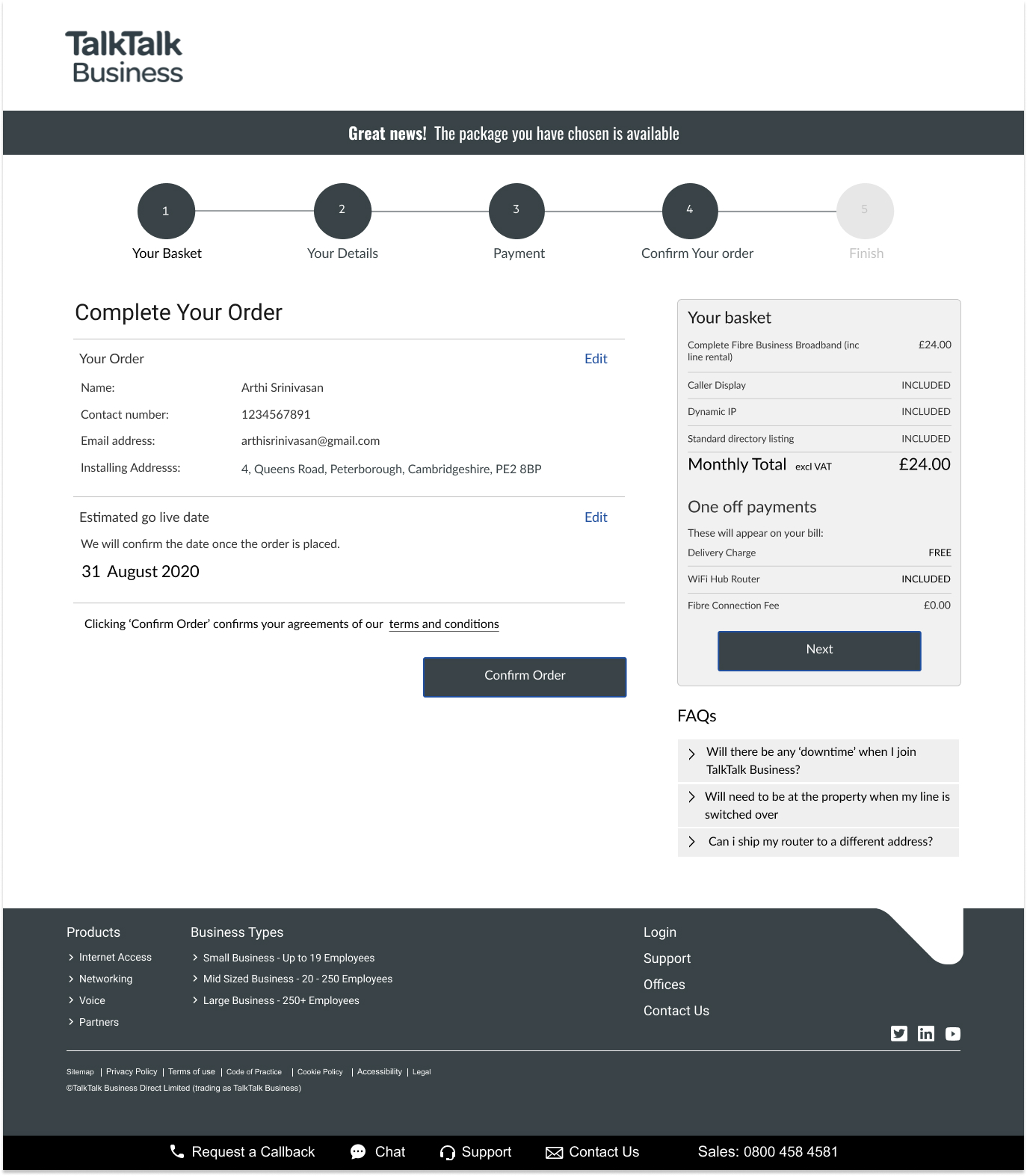Business Portal
Improving customer experience on their website
Business Portal
Problem Statement
The telecommunication company faced issues with a complex and outdated website that hindered customer experience and resulted in increased support requests. Additionally, inefficient order processing workflows led to lengthy processing times and high error rates for customer representatives, impacting overall operational efficiency.
Solution
The company redesigned its website for intuitive navigation and personalized content, added robust self-service features, and optimized for mobile use. It also integrated a CRM system, automated order processing tasks, and established an omnichannel support platform, resulting in improved customer experience and reduced order processing time by 40%.
My Role
I follow a thorough UX process to develop digital solutions that not only properly solve user needs, but also deeply resonate with users, improve their experience, and contribute to the company's overall success.
Scope
This project aims to enhance customer experience and efficiency for a leading UK telecommunication provider by revamping their website for better navigation and self-service options, integrating a CRM system to automate order processing, and establishing an omnichannel support platform to improve customer service and proactively address issues.
Design Thinking Process
Design thinking is an iterative, non-linear process which focuses on a collaboration between designers and users. It brings innovative solutions to life based on how real users think, feel and behave.

The Approach
To achieve the project objectives, the following approach will be taken:
Website Revamp:
User Research and Analysis: I've conduct surveys, focus groups, and usability testing to understand customer needs and pain points.
Design and Development: Collaborate with UX/UI designers to create a more intuitive and responsive website layout, integrating AI-driven personalization features.
Implementation: Develop and deploy new self-service tools, including comprehensive FAQs, troubleshooting guides, and an AI-powered chatbot.
Testing and Feedback:Perform rigorous testing to ensure functionality and gather user feedback for iterative improvements.
Order Processing Optimization:
CRM Integration: Select and integrate a CRM system that aligns with existing infrastructure, ensuring seamless data flow between departments.
Automation Implementation: Identify repetitive tasks in the order processing workflow and deploy automation tools to handle these tasks, reducing manual entry and errors.
Training Programs: Develop and deliver training sessions for customer representatives to ensure they are proficient in using the new CRM and automation tools.
Monitoring and Refinement: Continuously monitor the order processing system and make necessary adjustments to improve efficiency and accuracy.
Customer Support Enhancement:
Omnichannel Platform Development: Create a unified support platform that integrates phone, email, live chat, and social media channels, providing a consistent support experience.
AI-Driven Proactive Support: Utilize AI analytics to predict and address potential issues before they escalate, enhancing proactive customer support.
Feedback Mechanism Implementation: Establish a robust system for collecting and analyzing customer feedback, using insights to drive continuous service improvements.
Regular Updates and Training: Provide regular updates and training to support staff to ensure they are equipped to deliver high-quality service consistently.
Empathize Phase
Objective:
To gain a deep understanding of the customers' needs, experiences, and challenges with the current website and order processing system.
Activities:
Customer Interviews:
- Conduct one-on-one interviews with a diverse group of customers to gather insights on their experiences, pain points, and expectations.
- Focus on both business and consumer users to understand the different needs and challenges faced by each segment.
Surveys and Questionnaires:
- Distribute surveys to a broad audience to collect quantitative data on user satisfaction, website usability, and common issues.
- Include questions about order processing experiences and interactions with customer support.
Usability Testing:
- Observe users as they navigate the existing website to identify usability issues and areas of frustration.
- Record sessions to analyze specific pain points and behaviors.
Customer Support Data Analysis:
- Review customer support logs and call recordings to identify common issues and frequently asked questions.
- Analyze metrics such as average call handling time, first contact resolution rates, and customer satisfaction scores.
Stakeholder Workshops:
- Conduct workshops with internal stakeholders, including customer service representatives, sales teams, and IT staff, to gather insights from those who interact with the systems daily.
- Discuss current challenges and brainstorm potential improvements.
Competitor Analysis:
- Study competitors' websites and customer service processes to identify best practices and potential areas for differentiation.
- Evaluate competitors' strengths and weaknesses from a user experience perspective.
User Testing:
A combination of moderated and unmoderated testing was conducted with over 30 participants
Summary
Four user tests were conducted with 32 participants recruited through User Testing. The goal of the testing was to identify usability issues on the FTTP checkout flow. The first couple of tests were thirty-minute, moderated sessions. Participants were given a scenario requiring them to buy a fibre broadband package on the TalkTalk website up until the payment page. The second two tests followed a similar structure but were unmoderated. In both cases, participants were given dummy data to use for form filling.
Data collection and analysis
Data collected in the tests was primarily self-reports of participants think-aloud protocols. A data collection sheet was used to open code data during the sessions and afterwards from the video clips and transcripts. Questionnaire data including task expectations, completion and perceived usability. Time on task data was collected via manual timing of video clips and all of the resulting data was tabulated and compiled into this report.
Test structure and apparatus
Participants used their own desktop or landline computers to complete the task. They used a variety of browsers and completed all of the interactions they would need to do in order to purchase a fibre broadband package from TalkTalk. A couple of users went through the menu, but all went through the same journey from postcode, comparison, landline, add on, security and details page thereafter. A facilitator ran the moderated tests and the same script was used in the unmoderated tests. Questionnaires were also used in test including SEQ.
Limitations and bias
Manual timings made are not representative of actual time on task measures on the live site due to participants thinking aloud and these timings were done manually and so are not completely accurate. Page load issues and errors might affect participants SEQ scoring. More accurate data might be collected with reduced questionnaire load in the future.
Deliverables:
Customer Personas:
- Develop detailed personas representing key customer segments, including their goals, pain points, and behaviors.
Customer Journey Maps:
- Create visual maps outlining the steps customers take when using the website and interacting with customer support.
- Highlight moments of friction and opportunities for improvement.
Pain Points Report:
- Compile a comprehensive report summarizing the key pain points identified through interviews, surveys, usability testing, and data analysis.
- Prioritize issues based on their impact on customer experience and business operations.
Opportunity Areas:
- Identify specific areas where improvements can be made to enhance the customer experience and streamline order processing.
- Provide recommendations for the subsequent phases of the project.
wireframe



High-Fidelity Design
In conclusion, we successfully enhanced its customer experience and operational efficiency by leveraging insights from competitive analysis. The website was revamped for improved usability and mobile optimization, comprehensive self-service options were implemented, and a state-of-the-art CRM system was integrated to streamline order processing. The establishment of an omnichannel support platform ensured consistent and personalized customer interactions, while AI-driven proactive engagement addressed issues before they escalated. Embedding feedback mechanisms facilitated continuous improvement. These strategic actions have positioned the company to better meet customer needs, reduce processing times, and maintain a competitive edge in the market.
















